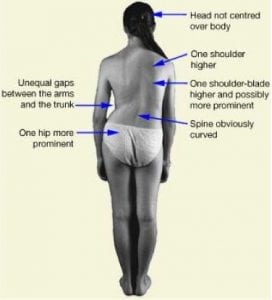Scoliosis is a serious condition which can cause discomfort, disability and eventually require major surgery if left untreated. Catching scoliosis early makes it much easier to treat, so this week please take a moment to read this quick primer on scoliosis and pass it on to those you care about.
What is scoliosis?
Scoliosis is a disorder in which there is a sideways curve of the spine. Curves are often S-shaped or C-shaped. In most people, there is no known cause for this curve, although those who have a family history of scoliosis do seem to be at greater risk.
What are the signs and symptoms of scoliosis?
In the absence of formal screening programs scoliosis is often first discovered by parents when they see an obvious curve or hump on their child’s back, especially when bending forwards.
Occasionally scoliosis might be detected through a complaint of back pain, but scoliosis is frequently present without pain.
Typical symptoms include:
- Uneven shoulders
- Head appears to be off centre
- Uneven waist
- One side of the rib cage is higher than the other when bending forward
How common is scoliosis
Scoliosis is much more common than most people think. The latest research suggests that between 2 and 3% of children aged 10-15 years will develop scoliosis. This might seem like a small number, but 3% would be 3 in every 100 – which would be one in every 30. Therefore, about one child in each school class will develop scoliosis.
Girls are more likely to develop scoliosis than boys (about 75% of scoliosis patients are girls) but boys can and do develop scoliosis too. Research suggests that some sports and activities are associated with a higher risk of scoliosis – the most notable example are ballet dancers and gymnasts, where the condition is us up to 12 times more prevalent[1][2].
How is scoliosis treated
If scoliosis is not diagnosed early, or if the scoliotic curve is left to develop unchecked then surgery to fuse the spine may eventually be required. It was once thought that this was the only effective means of treating scoliosis – which is one of the reasons why a screening program was not put into place. [3]
Today there are a wide variety of approaches which can be used to treat scoliosis non-surgically. These methods are far less physically invasive and much less emotionally disturbing, especially for young people. Evidence strongly indicates that non-surgical treatment can be highly successful in reducing the chance that surgery will eventually be required.[4]
Often, more than one approach can be used to develop a treatment program – the two main approaches used at our clinic are scoliosis specific exercise and scoliosis bracing, however we may also complement these approaches with evidence-based Chiropractic treatment or postural correction programs. While these additional tools do not directly reduce scoliosis, they can often assist the sufferer in terms of pain relief, or with regards to improving body symmetry.
What can I do?
The biggest single factor in ensuring a good outcome for scoliosis patients is early diagnosis – a very small curve is much easier to stabilise and correct than a larger one. June is Scoliosis Awareness Month. Throughout the month, our aim is to raise awareness about scoliosis screening and the importance of early detection -you can help by raising the issue of scoliosis with your child’s school, local clubs or youth groups.
This month, we are offering free scoliosis screening sessions and informational talks to schools. So if you know anyone who might be interested, please ask them to get in touch!
You can screen for scoliosis yourself, at home, using our scoliscreen tool – available at (https://scoliosisclinic.co.uk/scoliscreen/) if you’re a parent please feel free to use this tool to screen your own children. It’s an excellent idea to screen all children, but those between 10 and 15 are at the highest risk. If you do have a child who participates in a high-risk activity, please take a moment to screen them if you possibly can.
If you have concerns about a young person, please don’t worry – simply get in touch to book a free professional screening here at our clinic.
[1] Tanchev, Panayot I. MD; Dzherov, Assen D. MD; Parushev, Anton D. MD; Dikov, Dobrin M. MD; Todorov, Miroslav B. MD, Scoliosis in Rhythmic Gymnasts, Spine: June 1st, 2000 – Volume 25 – Issue 11 – p 1367-1372
[2] Longworth, Brooke et al. Prevalence and Predictors of Adolescent Idiopathic Scoliosis in Adolescent Ballet Dancers Archives of Physical Medicine and Rehabilitation , Volume 95 , Issue 9 , 1725 – 1730
[3] R Shands, JS Barr, PC Colonna, L Noall, End-result study of the treatment of idiopathic scoliosis. Report of the Research Committee of the American Orthopedic Association. J Bone Joint Surg 23A (1941) 963-977.
[4] M Rigo, C Reiter, HR, Effect of conservative management on the prevalence of surgery in patients with adolescent idiopathic scoliosis. Pediatr Rehabil 6(3-4) (2003) 209-14.


